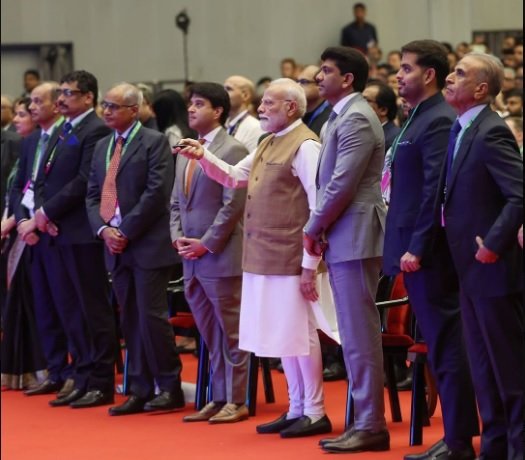Last Updated on October 8, 2025 4:37 pm by BIZNAMA NEWS
R. Suryamurthy / NEW DELHI
Prime Minister Narendra Modi today inaugurated the 9th edition of the India Mobile Congress (IMC) 2025, calling it a testament to India’s growing technological prowess and self-reliance under the Aatmanirbhar Bharat vision. Speaking at Yashobhoomi in New Delhi, Modi said India’s transformation from a 2G-dependent nation to one with near-universal 5G coverage reflects “the strength of India’s innovation, ambition, and resolve.”
“Digital connectivity in India is no longer a privilege or a luxury — it is an integral part of every Indian’s life,” the Prime Minister said, highlighting how widespread access to affordable data and indigenous technological innovation has made India one of the world’s fastest-growing digital economies.
India’s Telecom Leap: From 2G Struggles to 5G Saturation
Modi noted that the country’s telecom landscape has undergone a radical transformation in the past decade. “The nation that once struggled with 2G today has 5G in almost every district,” he said. Electronics production has grown sixfold since 2014, mobile manufacturing twenty-eight times, and exports 127 times, he added.
According to the Prime Minister, India has now launched its indigenous 4G stack, a milestone achievement that places it among just five countries in the world with this capability. “This marks a new chapter in India’s technological self-reliance. With our 4G and 5G stacks, India can deliver high-speed internet and reliable services while also exporting these technologies globally,” Modi said.
He revealed that on the day of the 4G stack launch, nearly one lakh 4G towers were activated simultaneously, connecting over two crore people, including those in remote and underserved regions.
Policy Reforms for a Digital Future
Underscoring the role of policy reform in sustaining this momentum, Modi cited the Telecommunications Act, which replaced the century-old Telegraph laws. “This law is not a regulator but a facilitator,” he said, adding that the streamlined approval system and faster Right-of-Way permissions have improved ease of doing business and accelerated fibre and tower network expansion.
The government, he said, has also given equal importance to cybersecurity, tightening laws against digital frauds and strengthening redressal systems. “We have made our cyberspace safer and our digital economy stronger,” he said.
Startups, Research, and the Atmanirbhar Vision
The Prime Minister credited India’s rise in telecom technology to a dynamic ecosystem of startups, researchers, and young innovators supported by government initiatives such as the Telecom Technology Development Fund and the Digital Communications Innovations Square.
“India’s success story is written by its youth and startups, backed by a government that believes in their potential,” he said. The government is also funding testbeds for 5G, 6G, and advanced optical communications, and encouraging collaboration between startups and research institutions to create indigenous technologies and global standards.
‘This Is the Best Time to Make in India’
Calling on global investors to seize India’s growth opportunity, Modi said the country offers the “manpower, mobility, and mindset” needed to lead the global digital economy. “India today has the second-largest telecom market and the second-largest 5G market in the world,” he said.
He urged companies to look to India for solutions to global supply-chain bottlenecks across telecom, electronics, and semiconductor manufacturing. “In mobile and telecom manufacturing, where the world faces constraints, India has the opportunity to provide solutions,” he said, noting that ten semiconductor plants are currently under development nationwide.
Reiterating his call for local value creation, Modi said, “Chipsets, batteries, displays, and sensors must increasingly be made in India. The world is generating more data than ever before — and India must become its trusted data hub.”
IMC 2025: Asia’s Largest Tech and Telecom Forum
Jointly organised by the Department of Telecommunications (DoT) and the Cellular Operators Association of India (COAI), IMC 2025 will run from October 8–11 under the theme “Innovate to Transform.” The four-day event will spotlight India’s leadership in next-generation connectivity, cybersecurity, quantum communications, and semiconductor technologies.
Over 1.5 lakh visitors, 7,000 international delegates, and 400 companies from more than 150 countries are expected to participate. The event will feature over 1,600 use-cases, 100 sessions, and 800 speakers, including leading policymakers, industry figures, and global innovators.
Union Minister for Communications Jyotiraditya Scindia and Minister of State Dr. Chandra Sekhar Pemmasani were present at the inauguration.
Innovation as a People’s Movement
Speaking later at a side session, Dr. Pemmasani said India is “democratising innovation,” transforming it from an elite pursuit into a people’s movement. “From college dorms to space missions, innovation is now a national habit,” he said, noting that India now ranks as the world’s third-largest startup ecosystem with over 1.9 lakh registered startups.
He added that India’s journey from connectivity to creativity — driven by reforms, digital inclusion, and indigenous innovation — “has made the world believe in India because India believes in itself.”
By combining 5G saturation, indigenous technology development, and startup-led innovation, India Mobile Congress 2025 showcased not only how far India’s telecom revolution has come but also how it aims to shape the global digital future.

